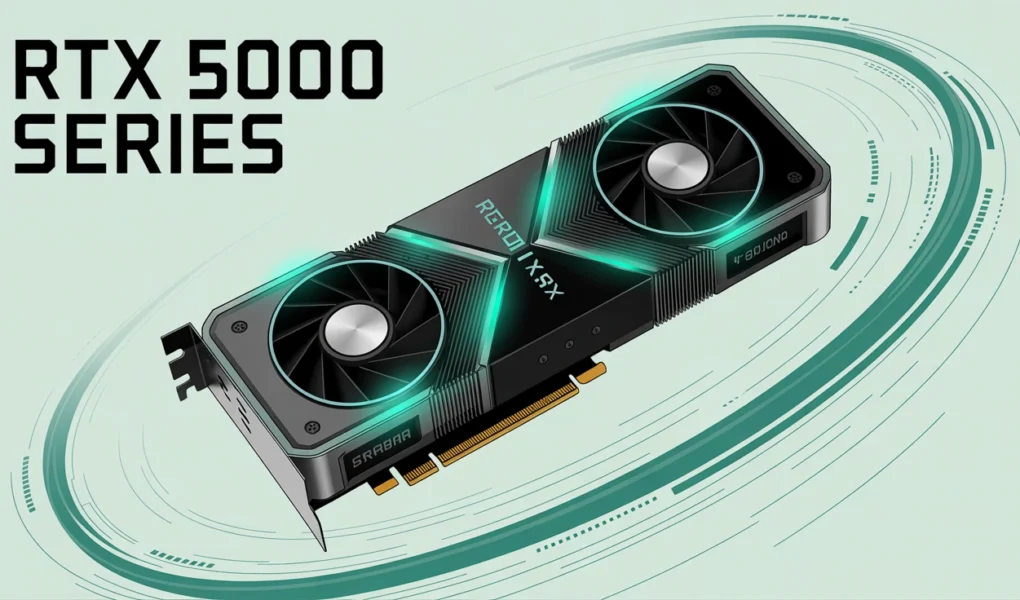The GPU market has always been a space where performance and innovation go hand in hand. With the release of the RTX 5000 series, NVIDIA has taken another bold step forward in the world of graphics processing units. These new graphics cards represent not only a massive leap in terms of gaming and content creation performance but also a refinement in the architecture that powers modern graphics rendering.
In this article, we will dive deep into the specs, features, and performance capabilities of the RTX 5000 series, exploring what makes these GPUs so powerful, and why they are a game-changer for both gamers and professionals alike.
What is the RTX 5000 Series?
The RTX 5000 series is the latest range of consumer-grade GPUs released by NVIDIA, building on the success of its predecessors, the RTX 4000 series. These graphics cards are designed to cater to both gamers looking for top-tier performance and creators working with 4K video, 3D modeling, and AI-driven tasks.
At the heart of these GPUs is NVIDIA’s new Blackwell architecture. This architecture is built on a 4nm process node, offering improved power efficiency and higher performance compared to previous generations. The introduction of GDDR7 memory and an upgraded version of DLSS (Deep Learning Super Sampling) further enhances the overall user experience, providing exceptional performance across a range of applications.
Key Specs of the RTX 5000 Series
When it comes to performance, the RTX 5000 series boasts several improvements over its predecessors, including higher memory bandwidth, better ray tracing, and cutting-edge AI features.
GPU Architecture: Blackwell
The Blackwell architecture is a significant leap forward in NVIDIA’s GPU design. The transition to a 4nm process node ensures that these GPUs are not only more power-efficient but also more capable of handling complex computations at higher speeds. This means that whether you’re gaming, rendering, or running AI algorithms, the RTX 5000 series will deliver smoother performance and greater overall efficiency.
Ray Tracing and Tensor Cores
The RTX 5000 series features 4th-generation RT cores and 5th-generation Tensor cores, which allow for enhanced real-time ray tracing and AI-driven tasks. Ray tracing simulates the way light interacts with objects in the real world, resulting in more realistic graphics with precise reflections, shadows, and lighting. These improvements create a more immersive experience for gamers and professionals working in fields like video editing and animation.
With DLSS 4, which is now available on these cards, users can achieve higher frame rates without sacrificing visual quality. DLSS 4 takes full advantage of AI to generate extra frames, boosting overall performance in supported games and applications.
Memory and Bandwidth
One of the standout features of the RTX 5000 series is its GDDR7 memory, which brings a significant improvement in memory bandwidth compared to previous generations. This allows the card to handle large textures and complex game environments without any stuttering or performance dips.
The addition of Neural Texture Compression (NTC) further optimizes memory usage, allowing for a more efficient experience in demanding games and content creation tasks. NTC can reduce VRAM usage by up to 90%, freeing up memory for even the most demanding tasks.
Power Efficiency and Cooling
Despite the increased performance, RTX 5000 series GPUs have been designed with power efficiency in mind. NVIDIA has integrated a variety of cooling solutions to maintain performance under load, including advanced thermal management features. However, the more powerful models, such as the RTX 5090, do require a significant power supply, which is something to consider if you’re upgrading from an older system.
Features That Set RTX 5000 Apart
The RTX 5000 series introduces several unique features that set it apart from both its predecessors and competitors in the market. These features not only improve gaming performance but also enhance productivity for professionals in creative industries.
DLSS 4: The Future of Performance Enhancement
One of the standout features of the RTX 5000 series is DLSS 4. Deep Learning Super Sampling has been around for several generations, but DLSS 4 takes it to a whole new level. With the help of AI, DLSS 4 generates additional frames, providing smoother gameplay and faster rendering times without losing visual fidelity. This is particularly beneficial for users working on graphics-intensive tasks, such as 4K gaming or 3D rendering.
Neural Texture Compression (NTC)
Neural Texture Compression is another cutting-edge technology introduced with the RTX 5000 series. It uses AI to optimize texture data, allowing for reduced VRAM usage by up to 90%. This means that even with high-resolution textures and complex environments, users won’t experience the same memory bottlenecks that have traditionally plagued GPU performance.
Advanced Ray Tracing Capabilities
The RTX 5000 series continues to push the boundaries of ray tracing. With its upgraded RT cores, these GPUs deliver incredibly realistic lighting, reflections, and shadows in real time. This is particularly noticeable in modern games and simulations where lighting plays a key role in immersion.
These enhancements not only make games look better but also improve the work of digital artists, animators, and video editors who rely on ray tracing for realistic visual effects in their projects.
Video Encoding/Decoding Support
For professional creators, the RTX 5000 series introduces advanced video encoding and decoding capabilities. The GDDR7 memory coupled with 4:2:2 color format support allows for better handling of video content, whether you’re streaming, editing, or creating professional-grade visual effects. These GPUs are equipped to accelerate workflows, improving efficiency in video production, 3D rendering, and other creative applications.
Performance Breakdown Across Models
NVIDIA’s RTX 5000 series is made up of several different models, each designed to cater to a specific type of user.
RTX 5050: The Entry-Level Card
The RTX 5050 is the entry-level model in the RTX 5000 series. Designed for gamers who want to experience 1080p gaming without breaking the bank, the RTX 5050 offers a great balance of performance and price. Although not as powerful as its higher-tier counterparts, it still supports ray tracing and DLSS technology, making it a solid option for those who don’t need top-tier graphics power.
RTX 5060 / 5060 Ti: Mid-Range Power
For gamers looking for more 1440p gaming power, the RTX 5060 and 5060 Ti are excellent options. With enhanced ray tracing and DLSS support, these cards are capable of handling more demanding games at higher resolutions while maintaining smooth performance.
RTX 5070 / 5070 Ti: High-Performance Gaming
The RTX 5070 and 5070 Ti are designed for gamers and content creators who demand high performance at 1440p and 4K resolutions. These models offer a significant jump in processing power, making them ideal for those who want to experience the most demanding games or run resource-heavy applications with ease.
RTX 5080: Enthusiast-Level Performance
For users seeking 4K gaming or professional content creation, the RTX 5080 is the go-to choice. It is equipped with cutting-edge features and offers excellent performance across a wide range of tasks, from gaming to 3D rendering and AI applications.
RTX 5090: Flagship Performance
At the top of the lineup is the RTX 5090, which is aimed at enthusiasts and professionals who demand 8K gaming and the highest possible performance in all areas. Whether you’re gaming at ultra-high resolutions, rendering complex 3D scenes, or working on AI-driven tasks, the RTX 5090 offers unparalleled power.
The Benefits of the RTX 5000 Series
The RTX 5000 series isn’t just about raw performance. It also offers several benefits that make it a compelling choice for both gamers and professionals.
Superior Gaming Performance
One of the biggest advantages of the RTX 5000 series is its ability to deliver superior gaming performance. With high frame rates, smooth graphics, and enhanced realism through ray tracing and DLSS, gamers can enjoy an experience that’s both visually stunning and highly responsive.
Enhanced Productivity for Creators
For content creators, the RTX 5000 series offers AI acceleration, ray tracing, and powerful rendering capabilities. Whether you’re working in 3D modeling, video editing, or machine learning, these GPUs are built to handle the demands of professional workloads with ease.
Future-Proofing for Upcoming Technologies
With the increasing demand for 4K and 8K content, the RTX 5000 series is built to handle whatever comes next. It supports the latest technologies, ensuring that users are prepared for future advancements in gaming, content creation, and AI development.
Energy Efficiency
Despite their impressive performance, the RTX 5000 series GPUs are designed to be more power-efficient than their predecessors. This ensures that users get maximum performance without sacrificing energy consumption or producing excessive heat.
Conclusion
The RTX 5000 series represents the cutting edge of GPU technology, delivering powerful performance, groundbreaking features, and efficiency improvements. Whether you’re a gamer looking to experience the latest titles in stunning detail, or a professional in need of powerful tools for content creation, the RTX 5000 series is built to meet your needs.
With its Blackwell architecture, advanced ray tracing, DLSS 4, and Neural Texture Compression, the RTX 5000 series sets a new standard for graphics cards, offering not only unmatched performance but also a future-proof solution for years to come.
READ MORE : Benny Blanco’s Net Worth: Music, Real Estate, and His Rise to Fame
FAQ
What is the RTX 5000 Series?
The RTX 5000 series is NVIDIA’s latest lineup of GPUs, featuring Blackwell architecture, GDDR7 memory, and improved ray tracing and DLSS capabilities. It’s designed for gamers and content creators looking for cutting-edge performance, including support for 4K and 8K gaming and advanced AI workloads.
What makes the RTX 5000 series different from the previous generation?
Compared to the RTX 4000 series, the RTX 5000 boasts higher memory bandwidth, better power efficiency, and enhanced ray tracing. The introduction of DLSS 4 and Neural Texture Compression allows for smoother performance and more efficient memory use.
Is the RTX 5000 series worth upgrading?
If you’re looking for high-performance gaming or working with AI, 3D rendering, or 4K content creation, the RTX 5000 series is a significant upgrade. The series delivers superior power and future-proofing features for demanding applications.
Which RTX 5000 model should I buy?
Your choice depends on your needs:
- RTX 5050 for budget-friendly 1080p gaming.
- RTX 5070 Ti and RTX 5080 for 4K gaming and content creation.
- RTX 5090 if you need the best performance for 8K gaming or professional workloads.
Are there any compatibility issues with the RTX 5000 series?
The RTX 5000 series GPUs may require a high-wattage PSU (power supply unit) and systems with sufficient PCIe 4.0 support. Always ensure your PC is compatible before upgrading, particularly if you have an older system.




